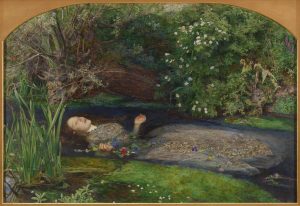Bellocq’s Ophelia by Natasha Trethewey is a powerful look into how women of the past (and possibly still today) were positioned in a man’s world. Although these poems take place in the early 1900s and are built around the prostitutes that Bellocq has so carefully photographed, what is most prominent about them is the fact that these topics about female autonomy are still prevalent today. The way that Tretheway presents these women solidifies the fact that Storyville was the direct product of how society viewed women. What is disheartening about them is the fact that although Storyville might be gone the society that created it is still present and the sexism that was there before is still here.
The poem entry under Letter’s from Storyville dated March 1911 is about the ideals that families instill in their daughters and how they translate to Ophelia’s work in prostitution. As young women, girls are often taught how to please men by being attractive, sociable, dainty, and graceful to be able to acquire a husband. This can be seen in a portion of the poem where Ophelia states,
“It troubles me to think that I am suited
for this work -spectacle and fetich-
A pail odalisque. But then I recall,
My earliest training -childhood-how
My mother taught me to curtsey and be still
So that I may please a whiteman, my father,
For him, I learned to shape my gestures,
Practiced expressions on my pliant face.” (Trethewey 20)
From this portion of the story, we are told how Ophila feels that prostitution doesn’t go against what was taught to her by her parents as from a young age it was ingrained in her to always please the male gaze. In the past the most education women got was based solely on etiquette and how to market themselves to a man. Thus, society inherently taught women they are only important for the pleasure that they can give men. Prostitution caters to this mindset that society has created as prostitution is after all just another way that women market their bodies to men. What is most disturbing about this statement Ophelia makes is that she indicates that any girl would be able to do her job as they all have been brought up and groomed the same way. To add to this issue is the fact that a man’s world makes no room for professional independent women so prostitution became the only answer for women to survive on their own.
At the beginning of this collection of poems, it starts with a few letters from the main character, Ophelia, to her friend Constance. In these letters we watch Ophelia go from a struggling independent woman to a prostitute. However, this was not a choice Ophelia wanted to make. As a woman of color, she couldn’t find work despite the fact that she was educated and eloquently spoken. Ophelia states, “No one needs a girl” (Trethewey 7). When Ophelia had no other option than to sell her body for food and housing she offered herself up to the imprisonment of prostitution. As it can be seen, the fact that men don’t allow room for women in a professional setting means they have no choice but to once again cater to men. It is almost as if the man’s world said, “if you can’t keep you locked away in the house then we will have you another way”. Readers continuously see this idea of ownership of a woman’s body presented throughout this collection of poems.
Under the Storyville Diary portion of this book is a poem called Bellocq where Ophelia is describing the scene of her posing for Bellocq’s pictures. The last few stanzas of the poem read, “I’m not so foolish that I don’t know this photograph we make will bear the stamp of his name, not mine” (Trethewey 39). What is so significant about this statement is that this picture with Bellocq’s name is physical proof of how men take ownership of the bodies of women. After all, this photo of Ophelia depicts her body in the way she decides to present herself yet Bellocq has decided to take claim of this image of Ophelia.
What makes these poems so revolutionary is the fact that Trethewey has thrown these prostitutes into the light as if they were some of the first radical feminists. When the United States talks about prominent women in our society who fought against the “man’s world” and rose to fame, we usually bring up women from wealthy families who had the resources and power to do what they wanted. We hardly ever talk about the women who were not so lucky to have those circumstances and had to give up their very bodies for their independence. Often prostitutes of the past are some of the most looked down upon characters of history. However, the poems that lay within Bellocq’s Ophelia show this specific group of women as the trailblazers of feminism and how the blame of these “crimes” they commit are actually to be blamed on the society that created them. The feminist movements that were started then are still present today for the sole fact that women still have to fight for ownership of their own bodies and their free will.


